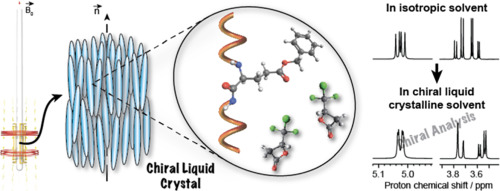Current Opinion in Colloid & Interface Science ( IF 7.9 ) Pub Date : 2017-11-15 , DOI: 10.1016/j.cocis.2017.11.001 Jonathan Farjon , Nicolas Giraud

|
Nuclear Magnetic Resonance in chiral liquid crystalline media is a powerful tool for deciphering mixtures of enantiomers. 1H NMR appears to be the most sensitive technique for analyzing enantiomers but remains very challenging for the analysis of chiral solutes interacting with weakly orienting media. Indeed, probing 1H networks even for small sized molecules is difficult because in oriented media, partially averaged anisotropic interactions such as residual dipolar couplings contribute to broaden NMR signals and lead to crowded spectra. For this reason, using 1H NMR for analyzing enantiomeric mixtures has long required a complex and tedious analytical process to extract a qualitative and quantitative information about each enantiomer. Several methods have been developed in the last decade to overcome this difficulty. SElective ReFocussing (SERF) based techniques allowed the possibility to get access to high resolution spectra and measure accurately every homonuclear 1H total couplings for each enantiomer. Among them, the Gradient encoded SERF (G-SERF) pulse sequence is an advanced tool for a rapid analysis of whole networks of residual dipolar couplings. Moreover, other multi-dimensional experiments have been developed to acquire homonuclear correlation spectra in which complex proton lineshapes of fully coupled systems are simplified. Finally, heteronuclear correlation methods that eventually combine the signal dispersion of another heteronucleus with the homonuclear decoupling of the proton dimension, were successfully implemented to separate lines from 1H sites in each enantiomer.
中文翻译:

使用手性液晶的对映体混合物的1 H NMR分析
手性液晶介质中的核磁共振是破译对映异构体混合物的有力工具。1 H NMR似乎是分析对映异构体最敏感的技术,但对于与弱取向介质相互作用的手性溶质的分析仍然非常具有挑战性。的确,即使对于小分子分子,也很难探测1 H网络,因为在定向介质中,部分平均的各向异性相互作用(例如残留的偶极耦合)有助于加宽NMR信号并导致光谱拥挤。因此,使用1长期以来,用于分析对映异构体混合物的1 H NMR需要复杂而繁琐的分析过程,以提取有关每种对映异构体的定性和定量信息。在过去的十年中,已经开发了几种方法来克服这一困难。基于选择性重聚焦(SERF)的技术允许访问高分辨率光谱并精确测量每个同核1的可能性每个对映异构体的H总偶联。其中,梯度编码SERF(G-SERF)脉冲序列是用于快速分析残留偶极耦合的整个网络的高级工具。此外,已经开发了其他多维实验来获取同核相关谱,其中简化了完全耦合系统的复杂质子线形。最终,成功实现了异核相关方法,该方法最终将另一个异核的信号弥散与质子尺寸的同核去耦结合在一起,以将每个对映异构体中1 H位点处的谱线分开。











































 京公网安备 11010802027423号
京公网安备 11010802027423号